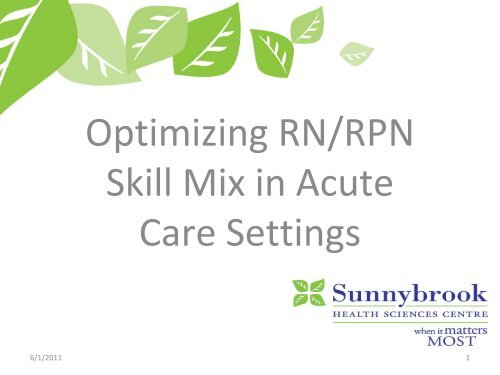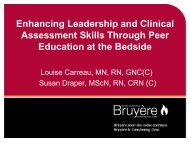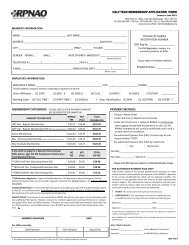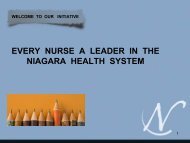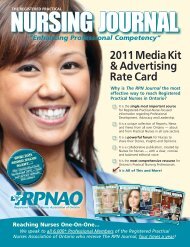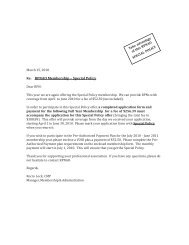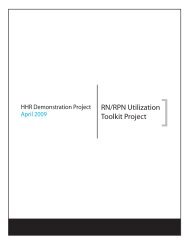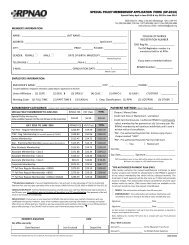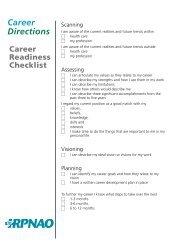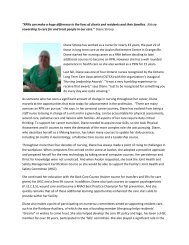Optimizing RN/RPN Skill Mix in Acute Care Settings - RPNAO
Optimizing RN/RPN Skill Mix in Acute Care Settings - RPNAO
Optimizing RN/RPN Skill Mix in Acute Care Settings - RPNAO
Create successful ePaper yourself
Turn your PDF publications into a flip-book with our unique Google optimized e-Paper software.
<strong>Optimiz<strong>in</strong>g</strong> <strong>RN</strong>/<strong>RPN</strong><br />
<strong>Skill</strong> <strong>Mix</strong> <strong>in</strong> <strong>Acute</strong><br />
<strong>Care</strong> Sett<strong>in</strong>gs<br />
6/1/2011 1
Tracey Kitchen‐Clark <strong>RN</strong>, MHS:L<br />
Dale Fraser, <strong>RN</strong>, B.Sc.N<br />
Patsy Cho <strong>RN</strong>, MScN<br />
Margaret Blastorah, <strong>RN</strong>, PhD<br />
Questions Email: tracey.kitchen‐clark@sunnybrook.ca<br />
6/1/2011 2
Acknowledgement<br />
• <strong>Skill</strong> mix project 2009<br />
• Validat<strong>in</strong>g the skill mix tool 2008‐2009<br />
• Publication:<br />
Blastorah, M., Alvarado, K., Duhn, L., Fl<strong>in</strong>t, F., McGrath,<br />
P., VanDeVelde‐Coke, S. (2010). Development and<br />
evaluation of an <strong>RN</strong>.<strong>RPN</strong> utilization toolkit. Canadian<br />
Journal of Nurs<strong>in</strong>g Leadership, 23 special issue.<br />
• L<strong>in</strong>k to website and tools: www.sunnybrook.ca<br />
http://sunnybrook.ca/content/page=Nurs<strong>in</strong>g_Practice<br />
6/1/2011 3
• Application of evidenced based research<br />
Outcome:<br />
•3 General Internal Medic<strong>in</strong>e units are now<br />
trial<strong>in</strong>g one year of <strong>RPN</strong>s on days & even<strong>in</strong>g<br />
shifts<br />
6/1/2011 4
Implementation of Pilot Project<br />
November 2010‐November 2011<br />
• Education of Leaders and <strong>RN</strong>s of <strong>RPN</strong>s<br />
expanded scope of practice<br />
• College of Nurses Ontario(CNO) 3 units= 90<br />
<strong>RN</strong>’s educated over 5 sessions<br />
• 5 sessions over 4 hours<br />
• 90% of leaders and <strong>RN</strong>s 3 units<br />
6/1/2011 5
Implementation of Pilot Project Cont<strong>in</strong>ued<br />
• Education from CNO: 3 Factor Framework<br />
• Framework for decision mak<strong>in</strong>g for assignments<br />
• Leaders‐ change management on units<br />
• <strong>RN</strong> accountability for mak<strong>in</strong>g assignments <strong>in</strong> total<br />
patient care model<br />
• Recruitment of <strong>RPN</strong>s<br />
• Orientation<br />
6/1/2011<br />
6
Implementation of Pilot Project Cont<strong>in</strong>ued<br />
Recruitment<br />
• Development <strong>RPN</strong> Role profile, competencies<br />
& skill sets<br />
• Interview panel composition: <strong>RN</strong>, PCM, HR &<br />
APN<br />
• Candidate –new <strong>RPN</strong> education program<br />
2005 or later<br />
6/1/2011 7
Three Factor Framework<br />
Nurse<br />
Knowledge,<br />
skill and<br />
judgment<br />
6/1/2011<br />
College of Nurses of Ontario<br />
Environment<br />
Support tools<br />
Consultation<br />
Stability of the<br />
environment<br />
Client<br />
Acuity of care needs<br />
Predictability of<br />
outcomes<br />
Risk of negative<br />
outcomes<br />
8
Challenges with Recruitment<br />
• >100 applications received, 62 <strong>in</strong>terviews set up, 10 decl<strong>in</strong>ed<br />
and 52 <strong>in</strong>terviews held , 8 hires <strong>in</strong> total<br />
• Challeng<strong>in</strong>g to stay with orig<strong>in</strong>al criteria‐ graduated 2005 or<br />
later<br />
Orientation<br />
• 6 corporate education days, 3 GIM orientation days and<br />
buddy shifts rang<strong>in</strong>g (10‐20 days)<br />
• same as <strong>RN</strong> competencies, except CVAD, (PICC only) different<br />
populations <strong>in</strong> 3 units<br />
• Ongo<strong>in</strong>g support with<br />
assignment mak<strong>in</strong>g, <strong>RN</strong> accountability<br />
6/1/2011<br />
9
Change Management<br />
The 3 phases of Transition<br />
1. End<strong>in</strong>g, Los<strong>in</strong>g , Lett<strong>in</strong>g Go<br />
2. The Neutral Zone<br />
3. The New Beg<strong>in</strong>n<strong>in</strong>g<br />
W. Bridges (2003). Manag<strong>in</strong>g Transitions<br />
Mak<strong>in</strong>g the Most of Change.<br />
http://www.wmbridges.com/images/model.gi<br />
f<br />
6/1/2011 10
Change Management<br />
• Talk<strong>in</strong>g at unit staff<br />
meet<strong>in</strong>gs, daily huddles,<br />
one on one, orientation,<br />
email, D2 portal<br />
• Time of ambiguity<br />
• Meet<strong>in</strong>g new Nurses,<br />
gett<strong>in</strong>g acqua<strong>in</strong>ted, trust<br />
build<strong>in</strong>g<br />
• Nurses express<strong>in</strong>g need for<br />
a guidel<strong>in</strong>e<br />
Unit C4, D4, D2<br />
• End<strong>in</strong>g , Los<strong>in</strong>g, Lett<strong>in</strong>g go<br />
• Neutral Zone<br />
• New beg<strong>in</strong>n<strong>in</strong>g<br />
6/1/2011 11
Staff Concerns‐ Initially<br />
•<strong>RN</strong> job loss Loss of <strong>RN</strong> l<strong>in</strong>e<br />
• How will the Nurses and Doctors know what <strong>RPN</strong>’s<br />
can and can’t do<br />
•Will they be able to manage <strong>in</strong>dependently<br />
because it’s busy<br />
•Policy gap, long term care advanced nurs<strong>in</strong>g<br />
competencies (ANC) very limited scope of practice<br />
• GIMAPN task to develop acute care ANC for <strong>RPN</strong>s<br />
6/1/2011 12
Change Management<br />
Unit level Transitions:<br />
Communication through out process<br />
Listen<strong>in</strong>g to concerns<br />
Act<strong>in</strong>g on concerns<br />
Psychological realignment<br />
Renewal<br />
6/1/2011<br />
13
6/1/2011<br />
14
Accountability<br />
TL/Charge Nurse Accountability: Screen<br />
Patient’s Stability for <strong>RPN</strong>’s Assignment<br />
“Stability is established by an <strong>RN</strong>”<br />
(College of Nurses of Ontario, Entry to Practice<br />
Competencies <strong>RPN</strong>, 2010).<br />
6/1/2011<br />
15
Guidel<strong>in</strong>es<br />
• <strong>RPN</strong>’s Not Assigned To: Patients with<br />
• Unstable vitals ly<strong>in</strong>g outside of normal<br />
parameters<br />
• Initiation (first 24 hrs) of remote telemetry<br />
• Diagnosis of TIA, Stroke patients admitted<br />
under 4 days<br />
• Transfers with<strong>in</strong> 24hours<br />
from ICU/ER<br />
6/1/2011<br />
16
Autonomy for <strong>RPN</strong> Assignment<br />
• Patient : NOT complex moderately complex or<br />
very complex <br />
• Environment :unstable moderately stable stable <br />
• Nurse: limited supports some supports many<br />
supports <br />
• Level of Autonomy: fully Independent partial<br />
collaboration with <strong>RN</strong> full collaborative model <br />
(if weekend or even<strong>in</strong>gs shift<br />
consider chang<strong>in</strong>g assignment<br />
if us<strong>in</strong>g full collaborative model)<br />
6/1/2011<br />
17
Nurse Knowledge, <strong>Skill</strong> and<br />
Questions to consider:<br />
Judgement<br />
• Is the nurse a novice, advanced beg<strong>in</strong>ner,<br />
competent, proficient, expert (Benner, P.<br />
(1984).<br />
• What is the level of knowledge, skill &<br />
judgment<br />
• Is an advanced competency required<br />
• What is the level of critical<br />
th<strong>in</strong>k<strong>in</strong>g <br />
6/1/2011<br />
18
Environment:<br />
Questions to consider:<br />
• What shift are we plann<strong>in</strong>g for<br />
• Is there a policy& procedure to support the<br />
care of this pt<br />
• Is there an established care plan<br />
• Is consultation available<br />
6/1/2011<br />
19
Patient Complexity<br />
Questions to consider:<br />
• What is the predictability of negative outcome Chang<strong>in</strong>g<br />
condition<br />
• Patient ‘s vitals stable Trach is mature or new Chest tube –acute<br />
or chronic<br />
• CVAD for patient wait<strong>in</strong>g long term care, remove device prior<br />
discharge<br />
• Blood transfusion for chronic anemia vs. acute GI bleed<br />
• Sub Q <strong>in</strong>fusion with narcotics for pt with stable pa<strong>in</strong> vs. unmanaged<br />
pa<strong>in</strong><br />
• <strong>Care</strong> plan <strong>in</strong> place for patient’s<br />
new diagnosis<br />
6/1/2011<br />
20
•2/8 <strong>RPN</strong> exited after<br />
orientation and a<br />
work<strong>in</strong>g period: 25%<br />
turn over<br />
•post exit <strong>in</strong>terview<br />
revealed lack of<br />
educational<br />
prep/experience for<br />
acute care sett<strong>in</strong>g<br />
prior to hire<br />
Lessons Learned<br />
• 3 factor framework is an<br />
excellent concept<br />
• Challeng<strong>in</strong>g to apply <strong>in</strong> a<br />
fast pace environment<br />
• Nurses preferred concrete<br />
guidel<strong>in</strong>es<br />
• Nurs<strong>in</strong>g care delivery<br />
model (primary<br />
care)challenges<br />
geographical assignments<br />
6/1/2011<br />
21
Lessons Learned<br />
• Challenged with recruit<strong>in</strong>g <strong>RPN</strong>s graduat<strong>in</strong>g<br />
from the new education program 2005 or<br />
later<br />
• 3 month delay from education to the staff on<br />
units to the time of orientation of new <strong>RPN</strong><br />
hires<br />
• Moral: <strong>RPN</strong>s experienced personal<br />
frustrations similar to be<strong>in</strong>g a new Nurse or a<br />
new hire when need<strong>in</strong>g to ask other <strong>RN</strong>s for<br />
6/1/2011<br />
help<br />
22
Evaluation<br />
Evaluation <strong>in</strong> progress: Did Nurse sensitive outcomes stay the<br />
same or get worse: <strong>in</strong>dicators of quality of care<br />
• Pa<strong>in</strong> management<br />
• Pt satisfaction/nurse satisfaction<br />
• Wound management, prevalence & <strong>in</strong>cidence pressure<br />
ulcers<br />
• Safety reports<br />
• Falls<br />
• Medication errors<br />
• Restra<strong>in</strong>t use<br />
• Assignment changes dur<strong>in</strong>g shifts<br />
(focus group)<br />
6/1/2011<br />
23
Case Study #1<br />
80 year old female, lives alone with no<br />
next of k<strong>in</strong>. Admitted with CVA off<br />
service to a renal floor. No care<br />
pathway available. Pt has mild<br />
cognitive deficits, is forgetful. Fallen<br />
once <strong>in</strong> hospital <strong>in</strong> BR, no <strong>in</strong>jury.<br />
6/1/2011 24
Case Study #1 Cont<strong>in</strong>ued<br />
• Today the pt’s BP is elevated (systolic 220<br />
mmHg). She has received one dose of an oral<br />
antihypertensive medication. Staff<strong>in</strong>g on the<br />
unit <strong>in</strong>cludes a new <strong>RPN</strong> reassigned from<br />
outpatients department to cover the unit <strong>RPN</strong><br />
who is on education leave. The <strong>RN</strong>s are<br />
regular unit staff and there are 3 students on<br />
the unit.<br />
Do you assign the pt to an <strong>RN</strong> or an <strong>RPN</strong><br />
6/1/2011<br />
25
Case Study #2<br />
47 year old female admitted 3 days ago for an<br />
<strong>in</strong>vestigation of a lower GI bleed. She is<br />
scheduled for a possible colonoscopy and<br />
abdom<strong>in</strong>al CT scan today. Her vital signs are<br />
stable ; she is alert and can perform self care.<br />
She has a history of depression and is on oral<br />
anti‐depressant medication. Her husband is<br />
present and her sister who is a Nurse.<br />
6/1/2011<br />
26
Case Study #2 Cont<strong>in</strong>ued<br />
There are pt <strong>in</strong>formation brochures about<br />
colonoscopy and the abdom<strong>in</strong>al CT scan. An<br />
additional <strong>RN</strong> has been reassigned to the unit<br />
from a unit with a reduced census.<br />
• Do you assign the pt to an <strong>RN</strong> or an <strong>RPN</strong><br />
6/1/2011<br />
27
Case Study 1<br />
Nurse: New <strong>RPN</strong>, <strong>RN</strong>s have 3<br />
students<br />
Environment: No Pathway<br />
available, plan for prevent<strong>in</strong>g<br />
future falls No mention of<br />
consultation available, no next<br />
of k<strong>in</strong>, admitted to wrong<br />
floor/bed spaced<br />
Client: mild cognitive deficits,<br />
unstable blood pressure<br />
<strong>RN</strong> assignment<br />
Case Study #2<br />
Nurse: extra <strong>RN</strong> on unit<br />
Environment: Sister and<br />
husband present, pt<br />
<strong>in</strong>formation brochures<br />
available<br />
Client: self care, vitals stable,<br />
on medication for<br />
depression (not new), pt<br />
aware and can verbalize if<br />
condition changes<br />
<strong>RPN</strong> assignment<br />
6/1/2011 28
6/1/2011<br />
29


